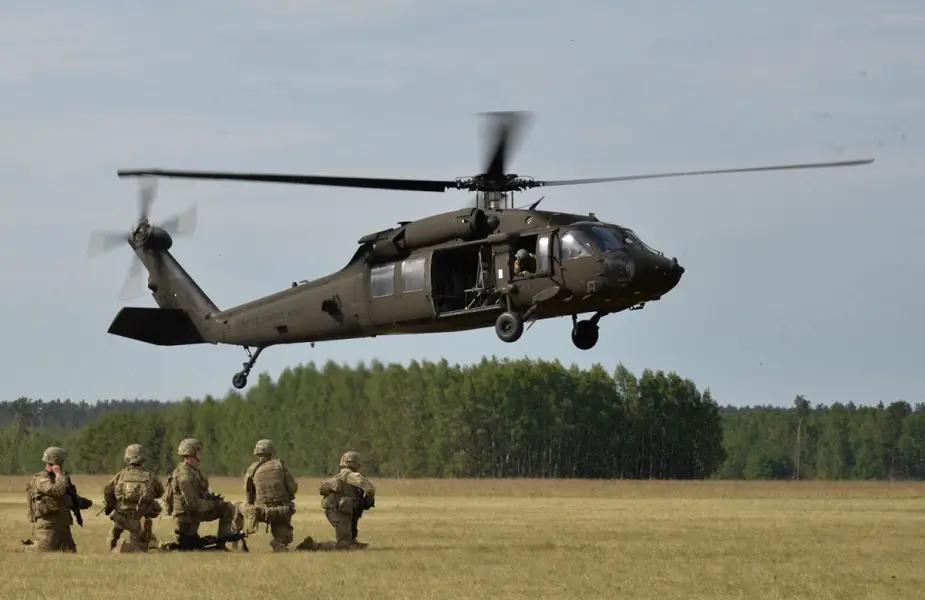Breaking news
US Army Future Vertical Lift eyes future skies.
Future conflict is likely to occur over wide areas and across multiple domains, according to recent US Army assessments of the future operational environment. To prepare for this probability and the rigors associated with it, the US Army is moving quickly to modernize legacy equipment and systems, including in the aviation space.
Follow Air Recognition on Google News at this link
 A UH-60 Black Hawk helicopter hovers above U.S. Army Soldiers during a multinational training exercise in Poland in 2017. The Army, which first began using Black Hawk helicopters in the late 1970s, has made iterative upgrades to the machine over the years and is pursuing additional, tech-enabled improvements for the future. The Army is also evaluating opportunities to introduce new helicopter models as part of its Future Vertical Lift modernization effort. (Picture source: US Army)
A UH-60 Black Hawk helicopter hovers above U.S. Army Soldiers during a multinational training exercise in Poland in 2017. The Army, which first began using Black Hawk helicopters in the late 1970s, has made iterative upgrades to the machine over the years and is pursuing additional, tech-enabled improvements for the future. The Army is also evaluating opportunities to introduce new helicopter models as part of its Future Vertical Lift modernization effort. (Picture source: US Army)
Guiding efforts to accelerate advances to the Army’s mission-essential helicopter fleet is the Army Futures Command Future Vertical Lift Cross-Functional Team, or FVL CFT.
Based at Redstone Arsenal, Alabama, the FVL CFT develops future-focused combat systems to ensure the Army maintains vertical lift excellence for years to come.
“FVL is modernizing Army Aviation with transformational speed, range and convergence, achieving decision dominance for the joint and coalition forces in multi-domain operations,” said. Maj. Gen. Walter “Wally” Rugen, Director of the FVL CFT.
For years, Army helicopters have provided the force with vital attack and reconnaissance, air assault and medical evacuation capabilities.
The FVL CFT understands that further improving these capabilities will sharpen warfighters’ abilities to penetrate enemy defenses, exploit open corridors and render swift emergency care to wounded Soldiers.
As a result, FVL CFT activities — which range from drafting capability documents for air launched effects and the modular open system approach to evaluating requirements for navigating successfully in a degraded visual environment — are skillfully designed to strengthen the Army and joint force’s ability to operate with increased lethality, survivability and reach on future battlefields.
Exploring possibilities for enabling and integrating more agile and powerful rotorcraft requires expertise in a variety of fields, which is why the FVL CFT includes scientists, aerospace engineers, IT experts, data analysts and Army helicopter pilots.
 A helicopter flies over desert terrain at Dugway Proving Ground, Utah, during the Army’s Experimental Demonstration Gateway Event 2022, also known as EDGE 22. The event, which took place from April 25 to May 13, was sponsored by the Future Vertical Lift Cross-Functional Team and provided participants opportunities to explore future warfighting capabilities, including swarming or air launched effects, electronic warfare, long-range fires and international partner integration. (Picture source: US Army)
A helicopter flies over desert terrain at Dugway Proving Ground, Utah, during the Army’s Experimental Demonstration Gateway Event 2022, also known as EDGE 22. The event, which took place from April 25 to May 13, was sponsored by the Future Vertical Lift Cross-Functional Team and provided participants opportunities to explore future warfighting capabilities, including swarming or air launched effects, electronic warfare, long-range fires and international partner integration. (Picture source: US Army)
Members of the team travel around the U.S. and world to collaborate with other CFTs; active-duty, National Guard and Army Reserve units; fellow DoD Services; and allies. As part of these broader teams, they carry out studies, modeling exercises, experiments and demonstrations to thoughtfully and effectively inform FVL modernization.
Thus far in 2022, the FVL CFT has contributed to multiple capability development documents, assisted in rapid acquisition processes to support urgent operational needs and enabled large-scale exercises as well as influential international partnerships.
In April and May, the FVL CFT sponsored the Army’s Experimental Demonstration Gateway Event 2022 — or EDGE 22 — at Dugway Proving Ground, Utah. The event offered 23 DoD organizations and seven multinational participants an opportunity to test new equipment and evaluate evolving vertical lift capabilities in a realistic warfighting environment. Lessons learned from EDGE 22, which tested 17 FVL-related technologies, feed into the development of Joint All-Domain Command and Control architecture and the building of mutually beneficial international partnerships.
In July, FVL CFT efforts helped facilitate the signing of a Future Rotorcraft Concept Analysis Project Arrangement between the U.S. Army and the Netherlands Ministry of Defence, paving the way for greater rotorcraft interoperability between the two nations. The event followed the signing of another future rotorcraft interoperability agreement, the Future Vertical Lift Cooperative Program Feasibility Assessment Project Arrangement, by senior representatives of the U.S. Army and British Army in February.
Employing Soldier-centered design principles and working in close coordination with the U.S. Army Program Executive Office, Aviation, the FVL CFT has also conducted Future Attack Reconnaissance Aircraft, or FARA, and Future Long-Range Assault Aircraft, or FLRAA, Soldier touchpoints and initiated a yearlong, multi-phase Soldier touchpoint involving the Future Tactical Unmanned Aircraft System. These hands-on events, which serve as equipment development accelerators, have helped the Army refine key aircraft requirements and prototypes, resulting in plans to down-select FLRAA competitive prototypes by the end of the year and FARA competitive prototypes in Fiscal Year 2024.
While the FVL CFT is intent on finding Army Aviation rotorcraft solutions that will embolden the future fighting force, it is equally passionate about protecting the Soldiers who will operate or be aided by these indispensable forms of military aircraft.
“Everything we’re doing in Future Vertical Lift is to support our warfighters — keep them safer, so they can do their job fighting and winning our nation’s wars,” Rugen said.



















